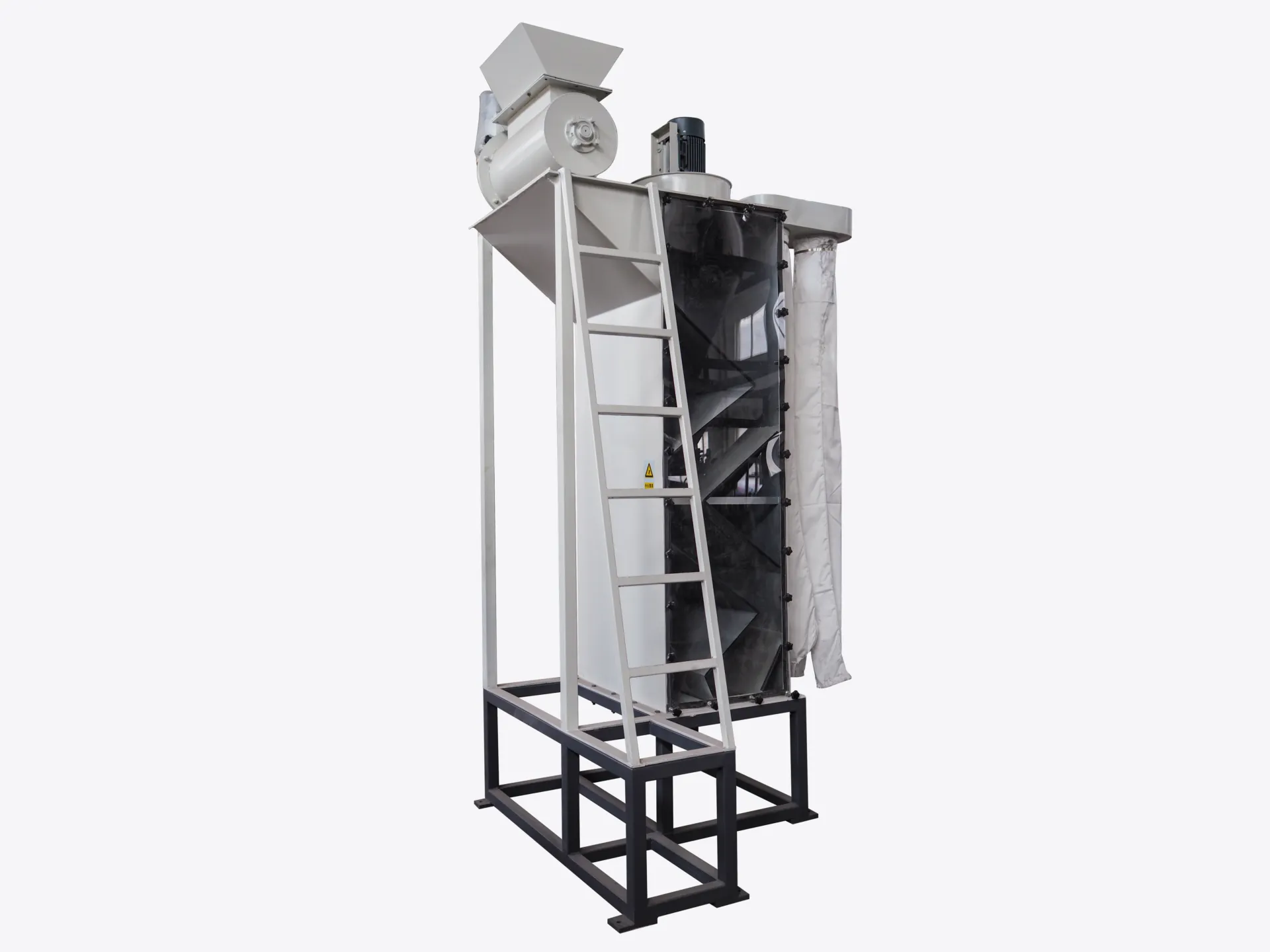W złożonym świecie recyklingu plastiku najważniejsza jest ostateczna jakość materiału pochodzącego z recyklingu. Osiągnięcie tej czystości wymaga serii wyrafinowanych procesów zaprojektowanych w celu usunięcia każdego śladu zanieczyszczenia. Podczas gdy kruszarki, pralki i suszarki często zajmują centralne miejsce, kluczowy i pomysłowy element wyposażenia pracuje cicho w tle: Klasyfikator powietrzny zygzakowaty, powszechnie znany również jako Separator etykiet Lub Separator powietrza w branży recyklingu.
Ta maszyna jest mistrzem separacji, wykorzystując prostą, ale wysoce skuteczną zasadę oczyszczania płatków plastiku. Ten artykuł zawiera szczegółowe wprowadzenie do tego, czym ona jest, dlaczego jest niezbędna i jak przyczynia się do udanej gospodarki o obiegu zamkniętym.
Czym jest klasyfikator powietrzny zygzakowaty?
Zig-Zag Air Classifier to mechaniczny separator, który segreguje materiały na podstawie ich zmiennej gęstości i profili aerodynamicznych. Jego charakterystyczna nazwa pochodzi od jego głównego komponentu: wysokiego, pionowego kanału zbudowanego w zygzakowaty wzór. Działa bez wody, co czyni go kluczowym komponentem „suchej” fazy separacji w nowoczesnej linii recyklingu.
Jego głównym zastosowaniem w przemyśle tworzyw sztucznych jest usuwanie lekkich zanieczyszczeń — zwłaszcza etykiet papierowych i foliowych, a także pyłu i drobnych cząstek — ze strumienia cięższych, pokruszonych płatków plastiku (takich jak PET, HDPE lub PP).
Krytyczna rola rozdzielania etykiet
Po zebraniu plastikowych butelek i rozdrobnieniu ich na płatki, otrzymany materiał jest niejednorodną mieszanką. Zawiera cenne płatki plastiku, ale jest silnie zanieczyszczony resztkami etykiet produktów, wkładek nakrętek i drobnym pyłem powstałym podczas rozdrabniania.
Jeżeli zanieczyszczenia te nie zostaną usunięte:
- Obniżają jakość końcowych poddanych recyklingowi granulek plastikowych, co prowadzi do przebarwień, osłabień strukturalnych i problemów z przetwarzaniem.
- Mogą się spalić i ulec degradacji w fazie topienia i wytłaczania, co powoduje uwalnianie się oparów i powstawanie czarnych plamek w produkcie końcowym.
- Obniżają wartość rynkową materiałów pochodzących z recyklingu, ponieważ producenci wymagają surowca o wysokiej czystości.
Klasyfikator powietrzny Zig-Zag stanowi pierwszą linię obrony przed tego typu zanieczyszczeniami, działając jako bramka kontroli jakości, która gwarantuje, że do następnego etapu przechodzą wyłącznie czyste płatki.
Jak to działa: opis krok po kroku
Genialność Zig-Zag Air Classifier polega na eleganckim wykorzystaniu grawitacji i przepływu powietrza. Proces można podzielić na pięć kluczowych kroków:
- Podawanie materiału: Mieszany strumień płatków plastiku i etykiet jest podawany do zasobnika znajdującego się na samej górze maszyny.
- Efekt kaskadowy: Z leja materiał spada do komory zygzakowatej. Kątowe przegrody zmuszają materiał do przewracania się i kaskadowania z boku na bok podczas opadania. Działanie to jest krytyczne, ponieważ rozbija wszelkie grudki i zapewnia, że każda cząstka jest indywidualnie odsłonięta.
- Przeciwprądowy przepływ powietrza: Jednocześnie potężna dmuchawa lub wentylator wypycha precyzyjnie kontrolowaną kolumnę powietrza w górę komory, przeciwstawiając się spadającemu materiałowi.
- Separacja w działaniu: To tutaj dzieje się magia.
- Ten ciężkie płatki plastiku mają wystarczającą masę, aby pokonać ciśnienie powietrza skierowane ku górze i kontynuować swoją podróż w dół do dolnego wylotu.
- Ten lekkie zanieczyszczenia (etykiety papierowe, folia plastikowa, kurz) mają dużą powierzchnię i niską gęstość. Są łatwo wychwytywane przez prąd powietrza skierowany ku górze i unoszone z głównego strumienia materiału.
- Podwójne rozładowanie: Maszyna ma dwa oddzielne wyjścia. Oczyszczone, ciężkie płatki plastiku są odprowadzane od dołu, gotowe do następnego procesu. Lekkie zanieczyszczenia są przenoszone przez powietrze z oddzielnego portu z boku lub na górze maszyny, gdzie są zbierane w worku filtrującym lub systemie cyklonowym w celu utylizacji.
Kluczowe komponenty i cechy konstrukcyjne
Jak widać w typowym projekcie, klasyfikator składa się z kilku podstawowych komponentów:
- Lej zasypowy: Miejsce, w którym zmieszany materiał wchodzi do układu.
- Komora separacyjna zygzakowata: Serce maszyny, zaprojektowane tak, aby zmaksymalizować wirowanie materiału i dostęp powietrza.
- Jednostka dmuchawy/wentylatora: Silnik procesu zapewniający regulowany przepływ powietrza w górę.
- System zbierania zanieczyszczeń: Otwór wylotowy podłączony do dużego filtra skarpetkowego lub cyklonu w celu wychwytywania oddzielonych, lekkich frakcji.
- Wyjście czystego materiału: Lejek u dołu, przez który wychodzą oczyszczone płatki.
- Rama wsporcza i dostęp: Solidna stalowa rama podtrzymująca pionową konstrukcję, często wyposażona w drabinę umożliwiającą dostęp w celu konserwacji.
Wnioski: Niezbędny atut dla jakościowego recyklingu
Choć może wydawać się prosty, Zig-Zag Air Classifier jest świadectwem genialnej inżynierii. Wykorzystując podstawowe siły grawitacji i powietrza, wykonuje niezbędne zadanie z wysoką wydajnością, niskimi wymaganiami konserwacyjnymi i minimalnym zużyciem energii. Jest to krytyczna inwestycja dla każdej poważnej operacji recyklingu, bezpośrednio przyczyniająca się do produkcji wysokiej jakości, wartościowych tworzyw sztucznych pochodzących z recyklingu i wzmacniająca podstawy gospodarki o obiegu zamkniętym. Jest to bez wątpienia jeden z niedocenianych bohaterów nowoczesnej linii recyklingu.



